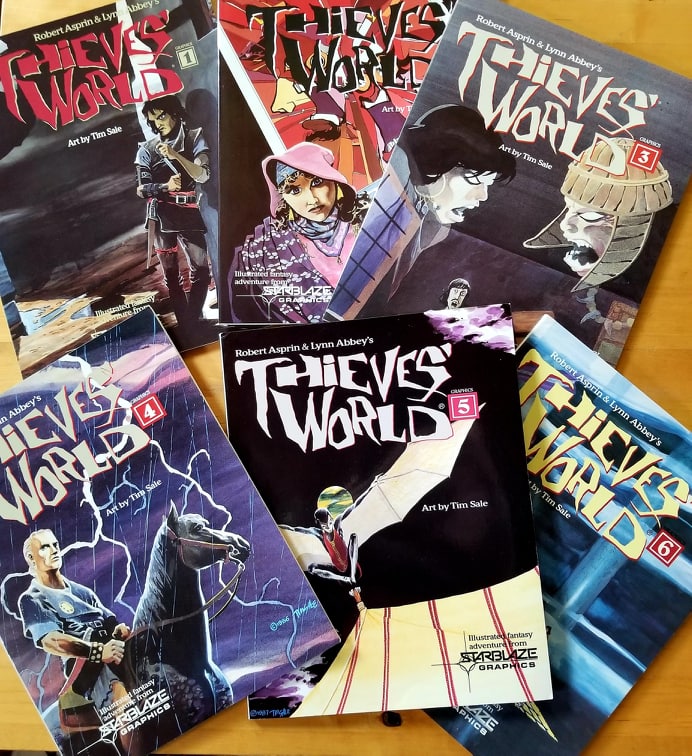
Based On: The Thieves’ World anthologies by Robert Lynn Asprin, Lynn Abbey et al.
Adapted for Graphic Fomat By: Lynn Abbey
Artist: Tim Sale
Editor: Laurie Sutton
Publisher: Starblaze Graphics
Available: 1985-1987, via a limited number of comic shops perhaps (but not likely) near you!
Price: Variable, depending on where you can find them, and in what shape…
Down from the Bookshelf for review this week is the Thieves’ World Graphic series, the comic adaptation of the Thieves’ World anthology collection by Robert Lynn Asprin, Lynn Abbey and a host of others. Abbey restructured a number of Thieves’ World tales (and wrote a few new ones) for the graphic novel format, and the books were drawn by none other than young and rising (at the time) artist Tim Sale.
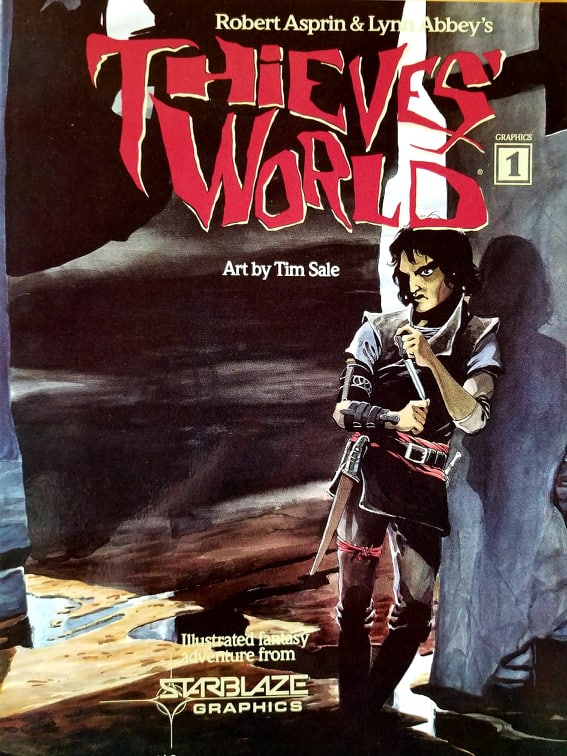
If you haven’t read any of the Thieves’ World anthologies, you’re probably not a sword-and-sorcery enthusiast. If that’s the case, these books (the novels or the comics) are probably not going to be your cup of grog. If, on the other hand, you label yourself a son or daughter of Tolkien, Leiber, Gygax and the like, and you’ve not read them, you should probably stop reading this, hunt down at least the first six books of the series (there were 12 in the original run) and get to reading. Dark and often sinister, though occasionally with a heart of at least…well…tin, at any rate, they were in my estimation some of the best fantasy fiction of their era (and, for the most part, since), a welcome counterpoint to the standard heroic quest fare which overloaded bookseller’s fantasy shelves at the time.
Essentially, Thieves’ World was a loose consortium of some of the best fantasy authors of the time (Asprin and Abbey, CJ Cherryh, Poul Anderson, Janet & Chris Morris and Andrew Offutt, to start the list) all writing short stories—anywhere from a few pages to a novella—centered around the city of Sanctuary and its environs. Each author contributed their own characters and centered their tales around them, but each character interacted in some way with some or all the others. And let’s be clear: while their ethics and morals varied, none of these characters were heroes. Further, a general mythology and politic flowed throughout the tales, moving chronologically as the books progressed. So really, it was almost like a unified comic book universe, only in prose and with blades, mail, interfering gods and magicks rather than mutant powers, capes and spandex.
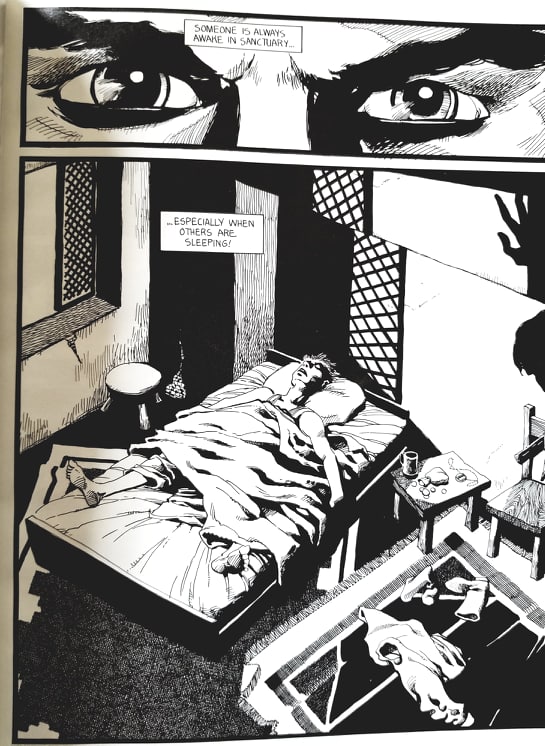
And what a city Sanctuary was.
Loosely inspired by Fritz Lieber’s Lankhmar, Sanctuary is an armpit town on the edge of the newly-conquering Rankan Empire, a city of former glory and trade which has watched its fortunes wane of late. With its recently-implanted governance by child-like Prince “Kitty-Kat” Kadakithis and his law-enforcers, led by the undying demigod Tempus and his Stepsons, the den of crime and poverty is experiencing a period of great cultural, religious, political and even magical upheaval. And this upheaval isn’t just amongst the local rabble themselves, but the very gods of the two clashing cultures.
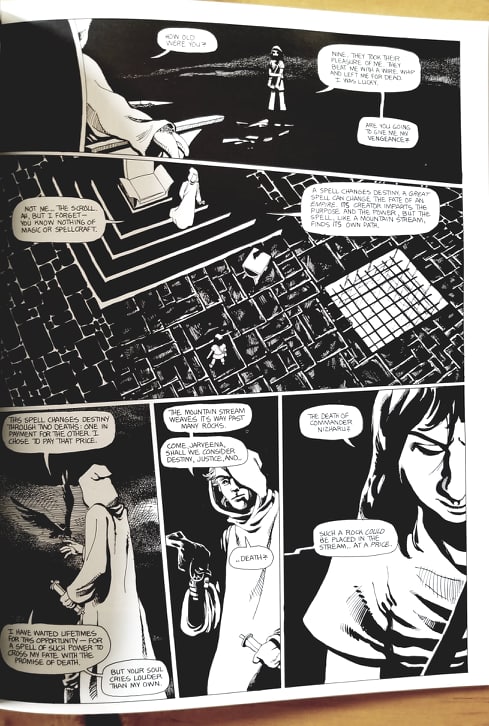
Cappen Vira the minstrel, Hanse Shadowspawn, Jubal the crime lord, Enas Yorl, the cursed wizard of the ever-shifting visage, Ischade the necromant, Dubro the blacksmith…these were some of the favorite characters of my youth (and, were you to have played any tabletop RPG’s with me at the time, you might have noticed some particular similarities between my characters and both Hanse and R.A. Salvatore’s Drizzt). Rich and supple, with razor sharp corners and smoky alleyways, Sanctuary was THE go-to fantasy setting of my youth. It had it all.
Anyway, Thieves’ World Graphics presents us with a number of these original and new tales, all featuring those great characters, typically three stories to a book and interwoven into a continuous graphic novel format. Perhaps not the easiest of reads, as the stories demand that the reader do the math at understanding the changing political tide in Sanctuary and its impact on its people, and as there is no single “main character” other than the city itself, it nevertheless captures much of the feel of the original books. Abbey, a converted computer programmer and European historian, did the lion’s share of the writing and re-writing, as she and then-husband Asprin worked with not-even-rising-star-at-the-time Sale (he’d worked previously on MythAdventures in 1983) to capture the flow, decay and dissonance that is Sanctuary.
Now, understand that these folks were not exactly working with the resources of Marvel Comics, or even Action Labs, at the time. They were largely winging it, figuring out the graphic medium as they went—and so there’s a bit here that’s a little rough around the edges. But, given those restraints and to the degree that they could, I’m thinking they nailed it.
While the art is certainly not Tim Sale at his peak—you’re not going to mistake any of it for The Long Halloween or Daredevil: Yellow—you will nevertheless witness signs of the great things to come. Specifically, his manipulation of light and dark shadow, and his employment of empty space as well as his bold line style are evident throughout (see below for some examples). Frankly, the more primitive black and white format of the books (I mean, they didn’t even use any kind of grayscale) actually force the issue: there’s no gradation, mix or explosion of color to differentiate tone or setting; it’s all up to the artist’s line and use of exclusively black ink.
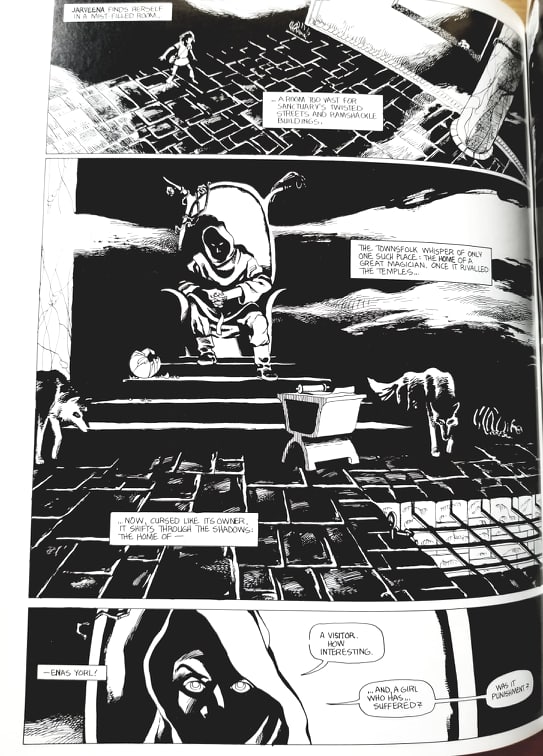
Sale has been one of my five favorite comic artists (with Adam Hughes, Frank Cho, Stjepan Sejic and John Romita…ok, six—John Buscema belongs there too…and Ashley Witter, and—ok, I’ll stop) since Spider-Man: Blue, and reviewing his work here is an interesting study in the growth of an artist’s style. Funny because, when I first encountered the books all the way back in high school, I didn’t know Tim Sale from Pablo Picasso; I just knew that I was at first disappointed that the book was all black and white (this being the first comic I’d read without that glorious four-stage color dot process the ‘80’s did so wonderfully), but then fascinated by how powerful the images could be for all that.
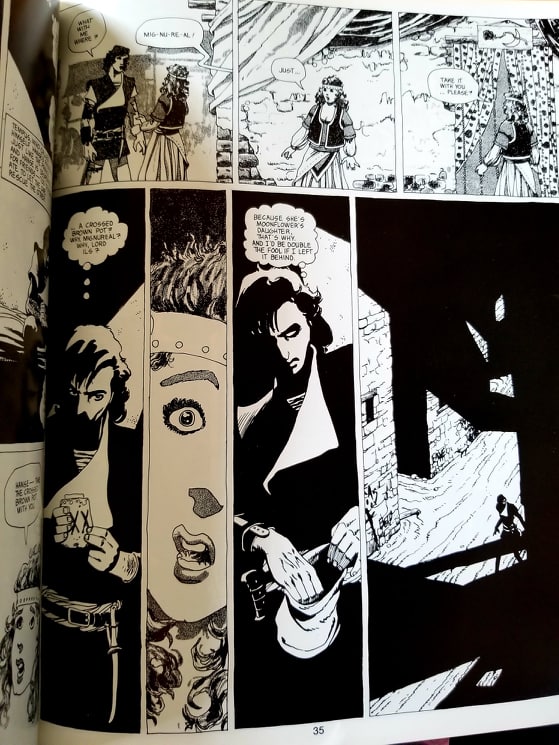
Which you’d think I’d have anticipated, given my favorite character, Hanse, was nicknamed “Shadowspawn.” To be fair, I never said I was the smartest kid in the room.
Regardless…Thieves’ World Graphics, if you can find them (more on that in a sec), are a great introduction to the city of Sanctuary and the world of, well, Thieves.
Now, just as with Rose & Thorn, finding copies of the Thieves’ World Graphics is going to be a challenge—though in my mind, that’s half the fun. I found mine (my current copies, that is; the ones I had in high school were long ago lost to time, space and my mom’s determination to clean the attic) via a combination of a flea market (issues 1-3) and eBay (issues 4-6 from Lyn Abbey herself—how cool is that?!? She even signed them, which I unabashedly show off below). You might be able to find them at cons if you find a dealer specializing in swords and sorcery and/or magazine-format material, or odd-ball stuff from the ‘80’s; unfortunately, these aren’t typical mainstream fodder. Elsewise, you might have luck at a gaming store or con, as Abbey is also known for having written for TSR (modern day Wizards of the Coast, for you younger folk) through much of the ‘90’s, and there was an actual Thieves’ World RPG from Chaosium in the ‘80’s and Green Ronin in the mid-aughts. If you are lucky enough to track them down, you shouldn’t have to pay an arm and a leg; I’d guess $5-10 a book ought to get you there.
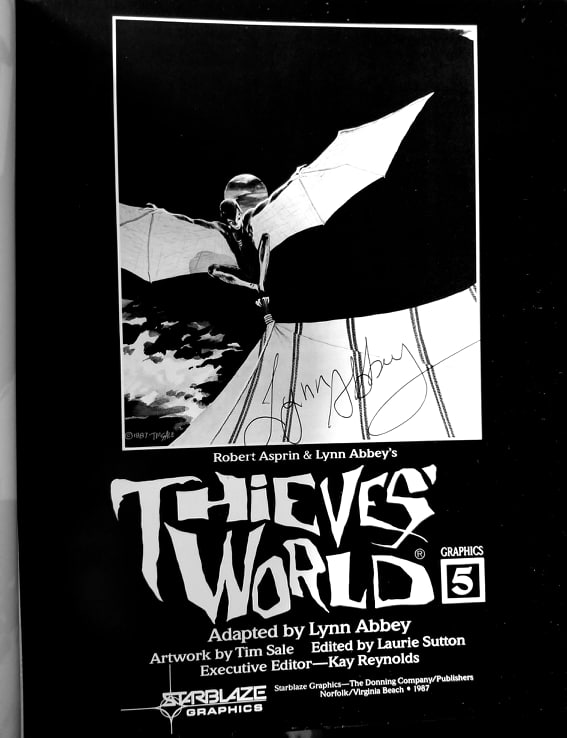
Thieves’ World Graphics, a colorized omnibus of the first three issues with a new cover by David A. Cherry, was published in the late-‘80’s as well, and is just slightly easier to find than the source books themselves. Being a bit of a purist snob, I definitely prefer the originals, though.
Score: 11/13
Review by Andy Patch, thePullbox.com